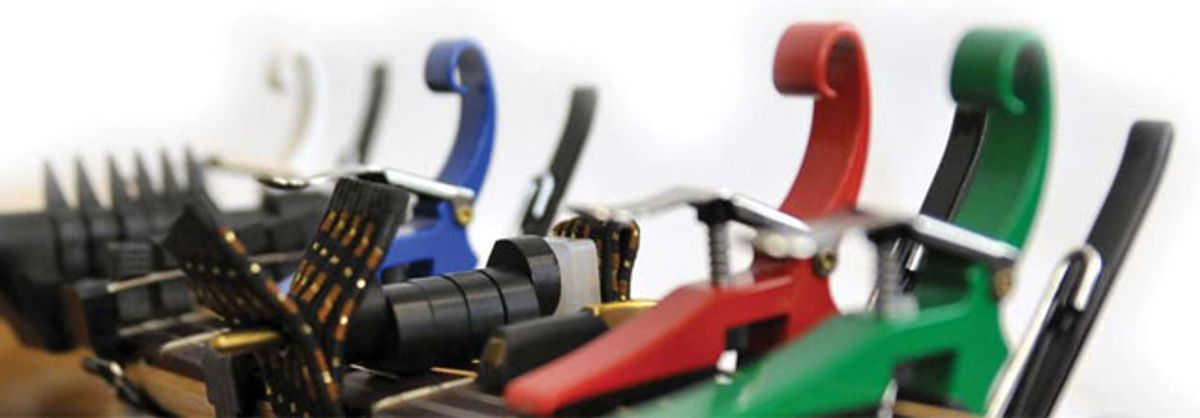Fixed, adjustable and “special” partial capos—which one suits your needs?
Guitarists have always been wild experimenters, using endless configurations of gear and gadgetry to get the sounds we’re seeking. Open tunings have long been a mainstay of that process, and recently partial capos have been letting guitarists get that open-tuning feel without actually going to all the trouble of tuning. With so many capo manufacturers offering this option, we decided to take a closer look and see what they have to offer.
A Partial Capo Primer
Before we dig in to the different models, it might be useful to talk a little about the different styles and applications of partial capos. The earliest experimenters, like Harvey Reid (who made himself a partial capo at home before there were any on the market, and helped to develop the Third Hand capo) would put their normal capos on either upside-down to leave the bass string open, or only part of the way across to get some droning treble sounds. Then some folks began to put multiple capos on, terraced down the fretboard, to create additional voices that could add bass or open-string style tension to a song.
If you want a crash course in what can be done with these gadgets, check out some of Harvey Reid’s music, or another early user, Ed Supple, who did a lot of session work in Nashville and used partial capos to create sounds that nobody has quite figured out yet. He also introduced Michael Hedges to the partial capo, and of course that opened up entirely new territories.
It takes a little adjusting to get the hang of playing with these capos, because although they do make the guitar sound like it’s in these altered tunings, it’s really not, and the chord shapes are not the open tuning shapes. With the DADGAD capo (because it’s really EBEABE, which is almost as much fun to say) or Open-G capo (which is really just a regular A-chord, and sadly unpronouncable— EAEAC#E), the open voice sounds like the tuning, but all the other chords are the same as in standard. Lead playing in first position is slightly complicated by having some of the strings ringing open differently, so they’re not terribly appealing for that purpose, but as a fingerstyle tool or in the hands of a great rhythm guitar player, they can give you a cool opentuning vibe without actually having to learn to play in one. Your guitar stays in whatever tuning it’s in, for example standard tuning, so you can play standard tuning chords and riffs above the capo and still have that open-tuning sound when you want. Some capos are low profile, allowing you to reach over to fret those missing bass notes, while others are not.
The Nitty Gritty
There are three broad categories: fixed, adjustable and, for the want of a better word, special. The fixed category contains the capos that block certain strings specifically, either from the bass side, or flipped to the treble side. The adjustable category contains the capos that cover all the strings, but allow you to choose which strings to leave open, basically giving you all the fixed capo options with a single device. The special capos don’t fit in either of these categories, and are unique unto themselves. We’ll be looking at three parameters in our evaluation: quality, ease of use, and usefulness. For these tests, the guitars stayed in standard tuning.
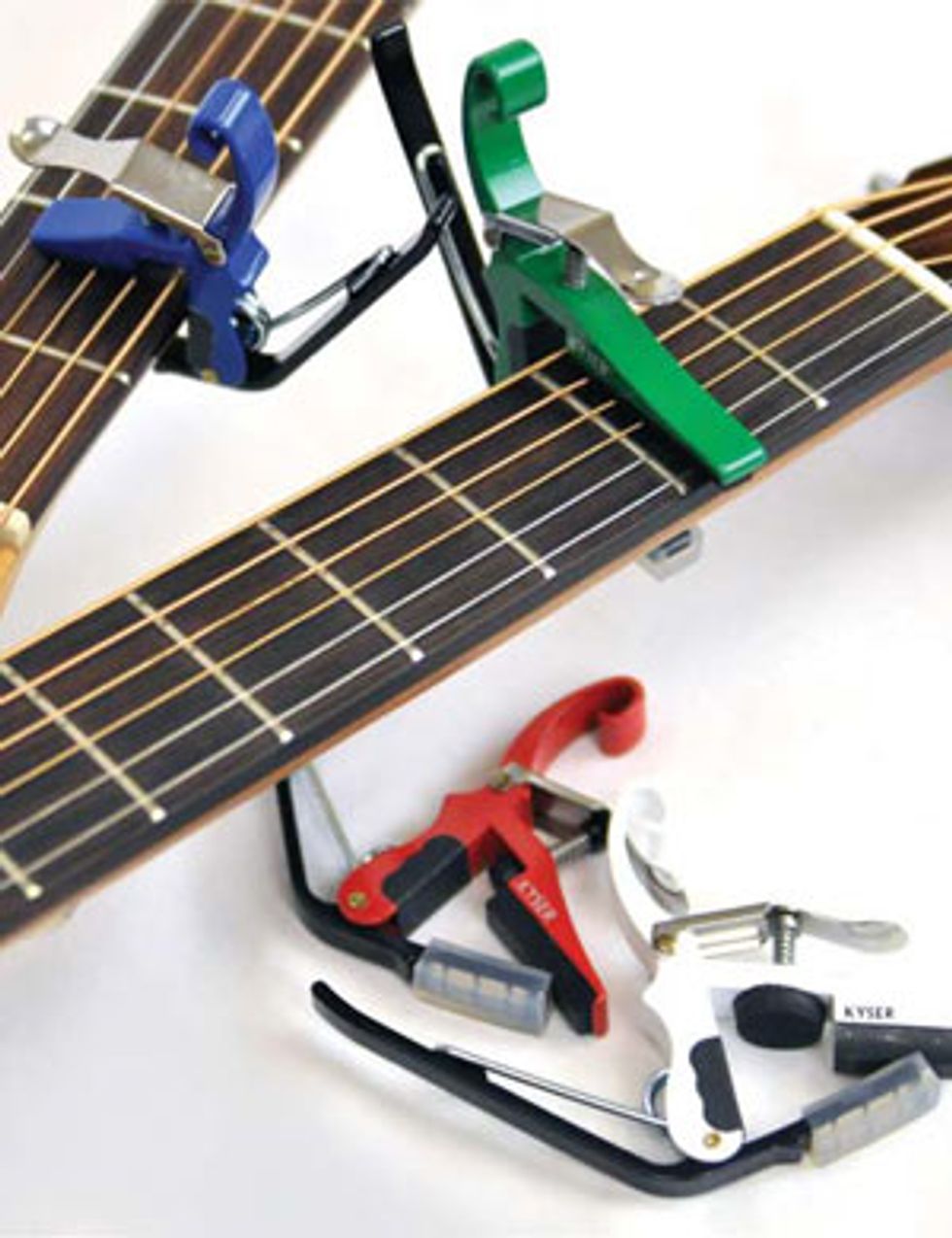 Kyser K’Lever |
Kyser sent us four different configurations to play with: Drop-D, Double Drop-D, Shortcut-to- DADGAD and Open G. The Kysers are sturdy, work exactly like they’re supposed to, and have a very nifty addition they call a K-Lever, which lets you catch the low D-string with your index finger should you want to play an F#m chord, which you probably will (though it takes a little planning to make sure you hit it right, and yes, with a little practice you can get a lovely hammer-on/pull-off effect with it). All four models are lightning quick to put on and take off, too.
Quality Top notch, nothing to be desired.
Ease of use Ridiculously easy and quick, and the K-Lever is pure genius.
Usefulness I could see these becoming a regular part of somebody’s stage rig.
MSRP $40
kysercapo.com
Shubb
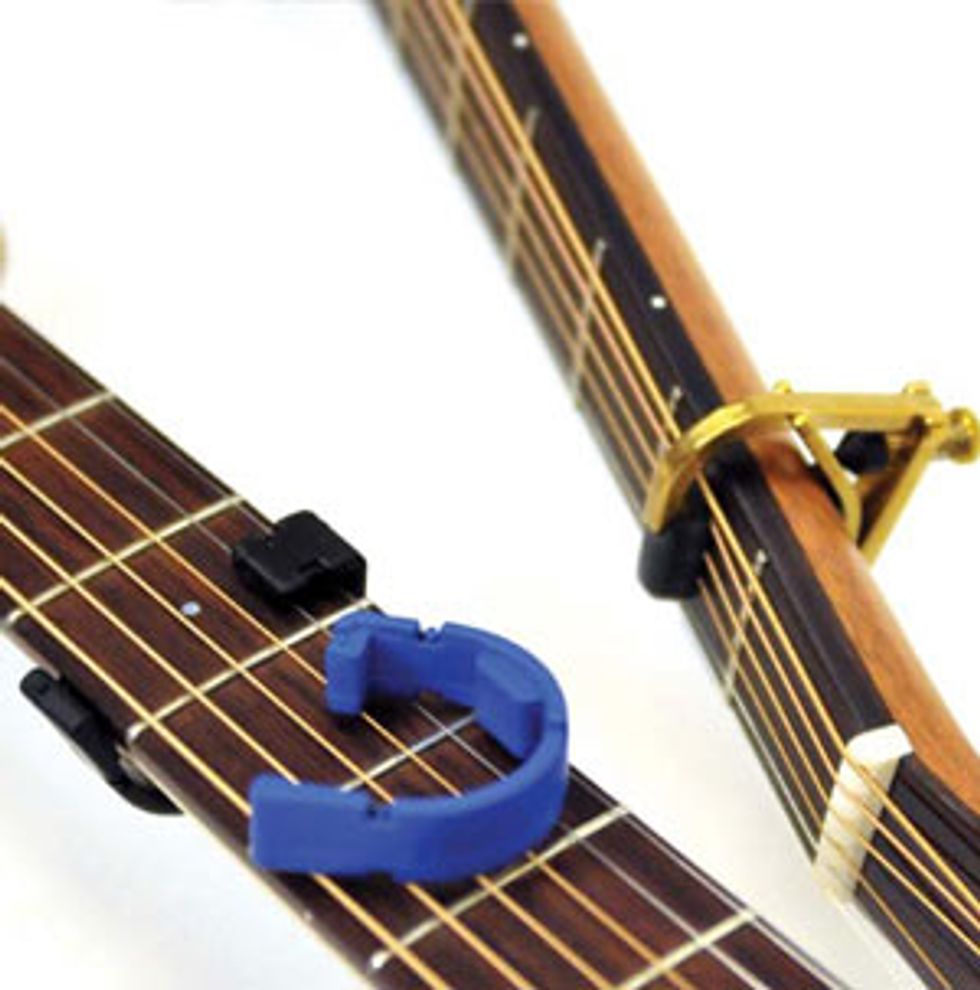 Left: Woodie’s G-Band and G-Band II Right: Shubb |
Quality Shubb’s stuff is always great, and this does not disappoint.
Ease of use Adjust for your guitar’s neck and snap it into place at the second fret; nice low profile allows for “reaching over” with a little practice.
Usefulness A useful tool that gives you two voices, it has a solid place in a professional setting.
MSRP $27
shubb.com
Woodie’s G-Band and G-Band II
The G-Band is like a clip that you clench on to either side of the fretboard to cover the bass or treble side only. The G-Band covers one string, and the G-band II covers two. I played with these a bit and didn’t really get a whole lot from them, so I surfed around on their web site and watched their video demo, and I got what they’re going for. If you want a high drone in the key you’re playing in, sort of like a 5-string banjo, then you can set a G-Band up for that kind of feel (depending on your guitar, you may even want to use metal fingerpicks and pick way down toward the bridge for a really twangy banjo-like sound). You can tune your low E and A strings down to D and G and put the G-Band II on the treble side at the third fret for some terrifically funky DGDGDG pickin’.
Quality They seem solid and sturdy enough, but I had a little trouble getting the G-Band II to fret clean on my 1-3/4" wide fingerboard.
Ease of use Easy as pie on a 1-11/16" fretboard.
Usefulness I could see this come in handy as a flavoring, sprinkled judiciously on a CD or in a set, but I don’t see it as a workhorse.
MSRP $16
wiamusic.com
Adjustable Creative Tunes Spider Capo
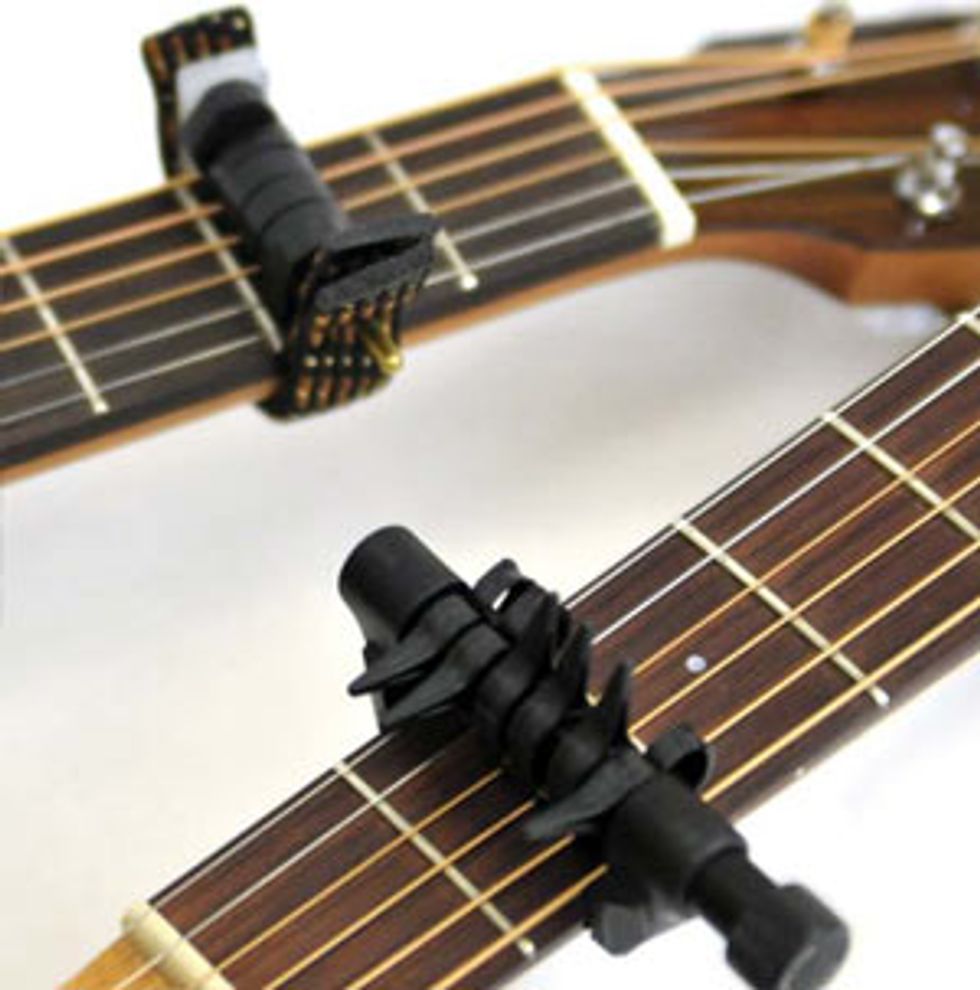 Top: The Third Hand Bottom: Creative Tunes Spider Capo |
Quality The components seem high quality, and it is well made.
Ease of use It takes a little doing to get it just right, but once it’s on it works well. The pointy finger handles do not allow you to reach over it to catch the lower bass notes in open-D settings.
Usefulness Winner of the Summer NAMM 2009 Best in Show Award, it is a versatile tool, but I have concerns about the time it takes to adjust, and whether it’s really securely attached.
MSRP $40
spidercapo.com
The Third Hand
This is certainly the lowest-tech capo of the bunch. I have some of the same reservations about the Third Hand capo as I do with the Spider, although it’s a lot easier to put on. But it’s not a quick change, and it’s a little finnicky. Once you have it on at the correct height, and you adjust the rubber string stops correctly so they’re directly over each string, it works great and is easy to use, and I didn’t have any trouble with it sounding mushy at all. Once again it’s very handy to have all of the “tuning” options in one tiny little package.
Quality Well made of quality materials, if a little low-tech looking. The elastic band will wear out after a while, but at $16 you can afford to get a replacement every couple years.
Ease of use It’s really pretty idiot-proof, and once you have it set up for your guitar it stays there, which is great.
Usefulness If you want many “tunings” in one device, the Third Hand looks like the way to go, and is the most affordable as well.
MSRP $16
thirdhandcapo.com
Special Bob Kilgore’s Harmonic Capo
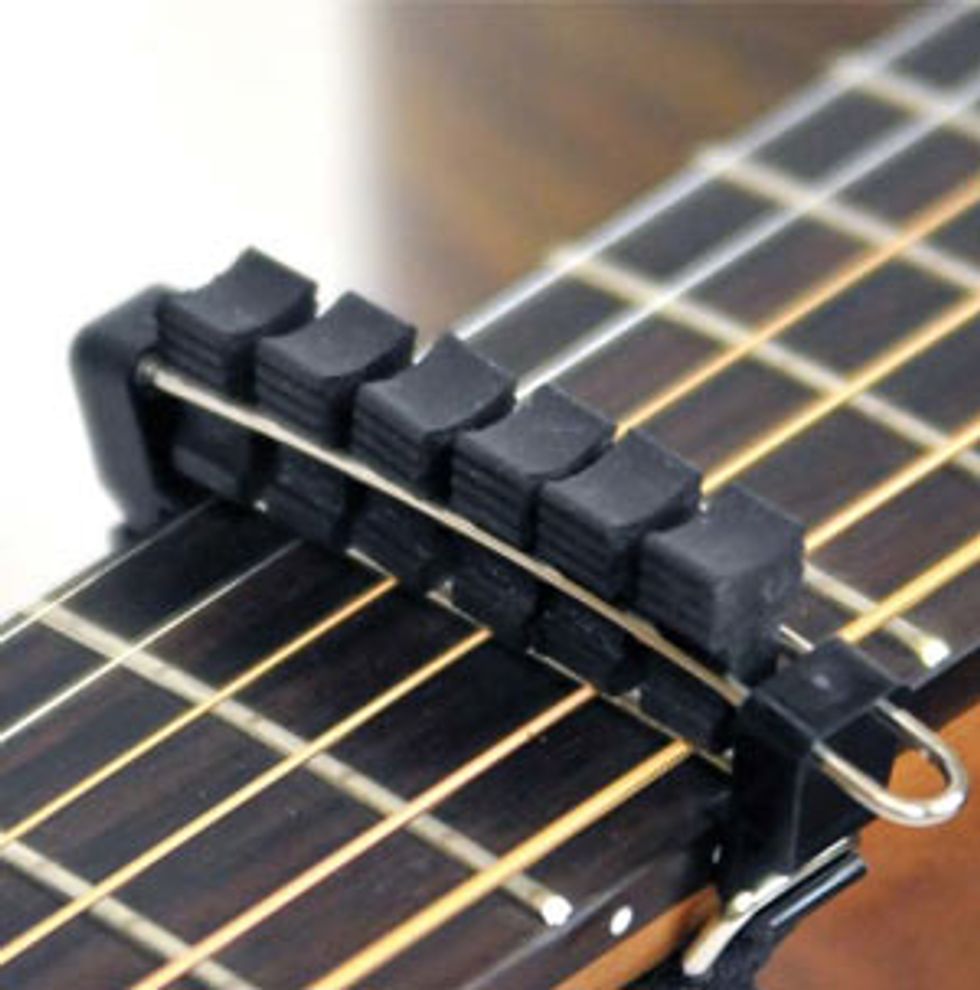 Bob Kilgore’s Harmonic Capo |
I got along with this capo better than any of the others, to a point. You can still fret the notes you’re “harmonicizing” (for want of a better word), but it takes quite a bit of planning and adjusting to get used to working around a device in the middle of the neck. I was rather hoping to put it at the twelfth fret, but none of the acoustic guitars at my disposal were shallow enough at the heel for the strap to reach over for a solid connection. I had some fun with the Telecaster, though, and could imagine someone with an electric guitar, a room full of pedals and a harmonic capo plugging in and not being seen for days. For atmospheric, arpeggio-based melodic pickin’ it’s extremely cool.
Quality Simply made, low-tech and sturdy, Weasel Trap offers affordable replacements for all of the parts that tend to wear out over time.
Ease of use Once you get the hang of playing around it, it will likely force you write new stuff simply because you have it.
Usefulness I can’t imagine this becoming the next must-have accessory, but solo guitarists and singer-songwriters could have loads of fun.
MSRP $35
weaseltrap.com
The Final Partial Mojo
Full disclosure time: I’m not partial to partial capos. As a devotee of altered tunings, I found these capos frustrating and confining. To my thinking, the point of an open or altered tuning is to get voicings that are impossible in other tunings all over the fretboard, not just when you’re open. Partial capos will not give you that, at least not in standard tuning.
But, if you don’t want to learn DADGAD or any other tuning, and you need to play convincing lead guitar and yet sound like you’re in one of those tunings, then partial capos may be a viable way for you to go. For solo guitarists and songwriters previously confined to the standard-tuning thing, partial capos may open up some inspiration, and for some, that’s worth the price of admission right there.
